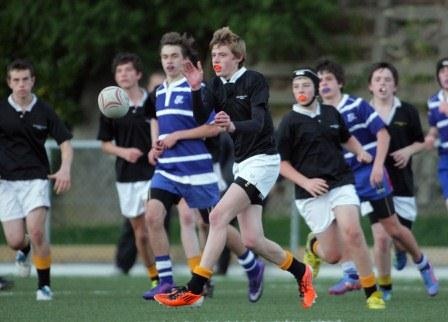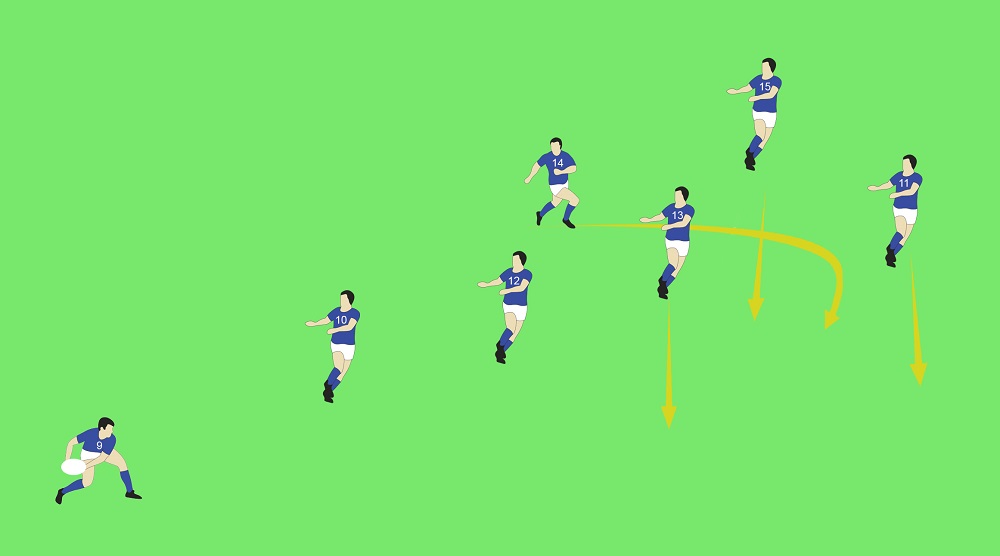- Rugby Toolbox
- Resources & Education
- Learn more
- Articles
- Snook on Coaching
- The Cut Out Pass
- Ruck & Run Drill
- Playing Philosophy – Ruck & Run Coaching Components
- Playing Philosophy – Spread the Forwards
- Playing Philosophy – A forward behind the ruck
- Playing Philosophy – Ruck & Run
- Playing Philosophy – An idea!
- The Breakdown
- Building Positivity [3]
- Building Positivity [2]
- Building Positivity
- Fitness and Game Related Activities
- Getting the Head Working
- Missiles are Dangerous
- Use of Video
- Winger Attacking Outside First-Five
- Player Profiling
- Selection
- Fitness Away from the Team Session
- Playing Philosophy (Pre season Prep)
- Coaching the Coaches
- The Rugby Coordinator and Pre-Season Preparation
- Why Not Use Tap Penalties More Often?
- Why Kick the Ball Down the Middle of the Field?
- Defending the 5 Metre Lineout Drive
- Scoring from the 5 Metre Lineout
- What are the Kicking Team Aiming to Achieve from Halfway Restart
- Should We Practice Scoring Tries?
- Team Culture
- Looking After Your Players
- Coach Survival Tips
- Under 11/13 – Backline Defence
- Under 11/13 – Ruck Defence
- Under 11/13 – Back Attack
- Under 13 – The Counter Attack
- Under 11/13 – The Maul
- Under 11/13 – Lineouts
- Under 11/13 – Decision Making
- Under 11/13 – Support Play
- Under 11/13 – Dive Pass and More
- Under 11/13 – Drop & Grubber Kick /Highball Catch
- Under 11/13 – Front on Tackling
- Under 11/13 – Contact – Getting Up – The Ruck
- Under 11/13 – The Coaching Session
- Under 8/10 – Using Space
- Under 8/10 – Kicking
- Under 8/10 – Contact and Picking Up the Ball
- U8/U10 Draw & Pass and Sidestep
- Under 8/10 – The Tackle
- Under 8/10 – The Coaching Session
- Under 7 – Test Your Coaching – Support Play
- Tap Pass and Swerve U7
- Ball Familiarisation; Passing & Receiving
- Activities for the Non-Contact Tackle
- Under 7 – The Coaching Session
- Coaching Teenagers – After the Ruck
- Coaching Teenagers – The Practice Session
- Coaching Teenagers – Best Practice
- Coaching Kids – Best Practice
- Plays from a Tap Penalty
- Running Plays from a 5 Man Lineout
- Driving Plays from a 5 Man Lineout
- Strike Plays at the End of the Lineout
- Back Strike Plays at the Lineout
- Wide Strike at the Scrum (2)
- Wide Strike at the Scrum
- Midfield Attack at the Scrum
- No 8 Plays at the Scrum (2)
- No 8 Plays at the Scrum
- The Cut Out Pass
- Skills to Penetrate (2)
- Skills to Penetrate
- Movements to Penetrate
- Patterns to Penetrate
- Contact and Continuity
- Keeping the Ball Alive Out Wide
- Pre Season Support Activities
- Checklist
- Understanding the game
- The Playing Philosophy
- The Lineout
- Overview
- Team Profile
- Start Now!
- Backrow
- Nine and Ten
- Rugby-related Fitness Activities
- The Psychological Edge
- Open Field Play
- Key Performance Indicators
- Improving Team Performance
- Backline Attack Concepts
- Tactics at Phase Play
- Playing Philosophy
- The ‘Stop Focus’
- Kick Attack
- Clearing the 22
- Wide Attack at Phase
- Player Focus
- Scrum Preparation
- Lineout Preparation
- Back Attack Preparation
- Sevens Preparation
- Sevens Kick Offs
- Sevens Scrum and Lineout
- Sevens Attack Patterns
- Sevens Defence
- 7's Selection and Game Planning
- Coaching and Leadership
- How the Game Evolves
- Changing Within the Game
- Learning from the Television.
- Using Tap Penalties Wisely
- Defence Drills
- Defence Drills for Tight Five
- Team Defence and TUB’ing
- Establishing Patterns from the Ruck
- Structured Phase Play
- Structuring Phase Play on the Run
- Coaching Roles
- Structuring a Close in Tackling/Defensive Session
- Coaching in Threes
- Attacking Back Play
- Kick Off Chase
- Wrap Around Back Plays
- Lineout Plans
- Looking and Learning
- Motivating Your Players
- Scrum Attack
- Refocusing the Team
- Monitoring the Progress
- Learning the Game
- Playing to the Laws
- Small is OK
- Decisions After the Tackle
- Improving Your Coaching
- Food for Thought
- More Food for Thought
- Passing & Catching
- How Ireland Nearly Beat the All Blacks
- The Progressive Coach
- Try Something New
- Encouraging Excitement
- The Mental Approach
- Where to Start
- Being the Best You Can Be
- Off the Ball Decisions
- Lineouts Difficult to Master
- Decisions on the Run
- Rucking and Rolling
- A Successful Approach
- Gaining Clarity
- Manipulation vs Physicality
- Beating the Drift
- To Ruck or Not to Ruck
- Stopping the Lineout Drive
- Fine Tuning the Planning
- It's a Running Game
- RugbySmart 2015
- Using the Shoulders
- Loosehead Prop / Tighthead Prop
- Position Specific – Hooker
- Position Specific – Lock
- Position Specific – Blindside Flanker
- Position Specific – Openside Flanker
- Position Specific – No 8
- Position Specific – Halfback
- Position Specific – First Five Eighth
- Position Specific – Second Five Eighth
- Position Specific – Centre Three-quarter
- Position Specific – Wing
- Position Specific – Fullback
The Cut Out Pass

In the NZ Rugby Manual 'Developing Rugby Coaches' there is a section on 'Handling' with a sub- section looking at the 'Cut Out Pass'.
If used in set play or phase play it allows the attack to play reasonably flat with the penetrating player running from slightly deeper and drifting inside their opponent or outside their opponent before receiving the ball and accelerate in to a space.
This should only be used if the defence is tight on the ball carrier and they have scanned to see that there is greater space out wide. In a set play it may come from 10 hitting 13 or 15 or even the wing, dependent upon the defensive structure.
In phase play the first or second receiver might miss one or two players in much the same way. These can be planned and practiced or played as the opportunity arises.
It is helpful if the players in the wide positions relay the message through to the inside ball players that the defensive line is thin where they are positioned.
One of the worst features of play at any level is the number of times the cut out pass is used before the defenders are committed on the inside which allows the defence to drift across and cover the receiver. What was possibly a 4 v 3 quickly becomes a 1 v 3. Make sure the team are able to seize upon the right times when to use this pass.
Creating a pattern that can be utilised as a starter or in phase is fairly simple. The important aspect is each player doing his role correctly.

“Cut 3”: 9 passes to 10 / 10 passes to 12 / 12 passes in front of 13 who has run forward ready to take a pass and the ball is receive by 15 / 15 either heads through a space or if they have a defender in front of them they will target the outside shoulder and pass to 11 / 11 will have space or a passing option to 14 / 14 should also be working before they receive the ball to change their angle to hit a ball going inwards or on a wider drift.
“Cut 35”: Same pattern with 12 hitting 11 in front of 13 and 15. This is useful from set play but may be harder to set up at phase play. Not impossible though if it is practiced often enough.
From the NZ Rugby Coaching Manual – Developing Rugby Coaches
Cut Out Pass
Objective
To transfer the ball past a decoy player to another teammate. in order to destabilise the defensive screen.
Key Factors
• Long, flat and quick pass.
• Aim through the decoy’s hands.
• Missed player puts hands out and appears to catch the ball to ensure his defender stays marking him.
• Pass in front of the receiver.
• The spiral pass is a good option.
Coaching Points
• Use basic passing skills or a spiral pass.
• The decoy runner must be in a position to receive the pass or this won’t distract the defenders.
• The receiver should be running onto the ball from depth and accelerating once he catches the ball and has moved in to the space he is going to run in to.
Common Errors
• Passing player not focusing on a target.
• No follow-through with the arms and fingers after the pass.
• Ball propelled on incorrect plane. Too high; too low; not in front.
• Decoy not effective.
• Drifting with the pass which allows the defender/s to drift off early and cover the ball receiver.
• Using the cut out pass when it should 'go through the hands'.